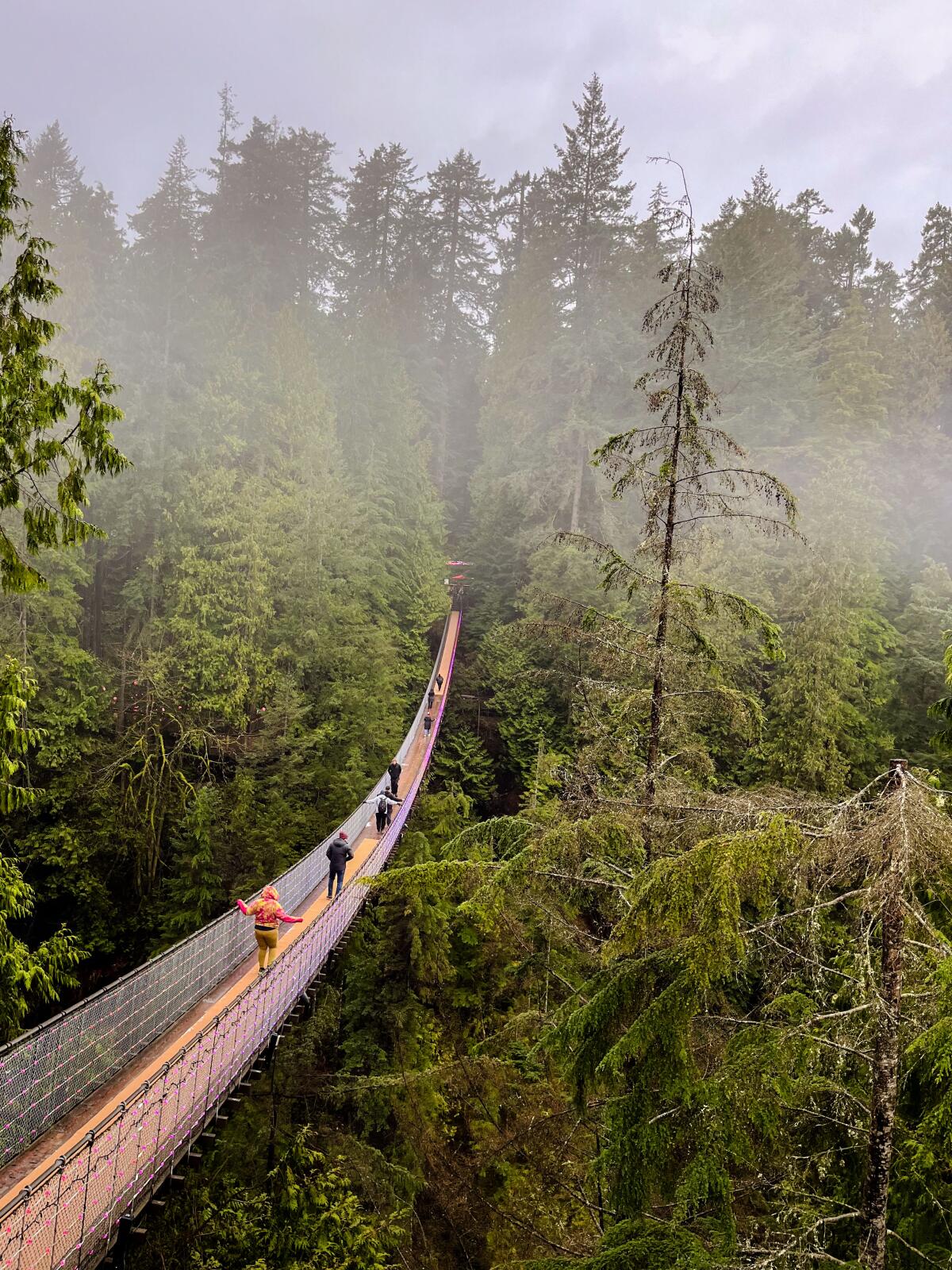
14 glorious things to do in Vancouver, the ‘California of Canada’
- Share via
It was a sunny day in Vancouver, Canada. From the beach at English Bay (like Santa Monica, but cleaner), you could see snow atop the mountains and hear kids laughing. After a bike ride in Stanley Park (like Griffith Park, but with beaches), I had just bought a hot dog from a cart and taken two bites when a voice rang out.
“No,” it shouted, startled and helpless.
That’s when everyone by the beach turned my way, with faces showing great concern. Because it was my voice. A sea gull had swooped, grabbed my hot dog and carried it away. The shout had left my body before I could think.
Immediately, the Vancouverites understood this. Then, with the same equanimity that allows so many Canadians to commit violence in ice rinks while displaying civility at all other times, they turned away and resumed their day.
Planning your weekend?
Stay up to date on the best things to do, see and eat in L.A.
Let this be a lesson, all you who daydream of escaping to this place that people call the California of Canada. Amid the seaside parks, forest paths, stylish skyscrapers, good food and mingled cultures, you may begin to suspect that Vancouver is a superior version of home. But its seagulls are no better than ours.
In fact, the city is full of moments like that for a Southern California visitor. One minute, you’re feeling at home or slightly better than you do at home. The next, you’re confronting a menu full of poutine. Or realizing that the toilet is in a place called the Washroom. Or getting rained on.
Everyone drives on the right, but somehow, no freeways connect to downtown.
Every year, movie, TV and streaming studios spend billions on shoots here, yet much of the time Vancouver is standing in for Seattle, San Francisco or some other city.
There’s volleyball on the beach — but when the temperature dips near freezing, they keep playing.
And all the while you hear people speaking English that’s mostly like ours, but the signage is riddled with references to travellers, colours, harbours and Tim Hortons. (Horton, whose name is on Canada’s leading coffee-shop chain, was a pro hockey player and, apparently, an enemy of possessive apostrophes.)
This almost-familiarity kept me on my toes through several days of roaming Vancouver in March. For all those thinking about their own escapes, here are 14 very Vancouver adventures.
By the way, I’m talking about a short-term escape, not a post-election change of residence. I’ve also included a few spots on Vancouver Island, a popular side trip. All the prices here are in U.S. dollars. (At recent trading rates, $1 U.S. is worth $1.34 Canadian.)
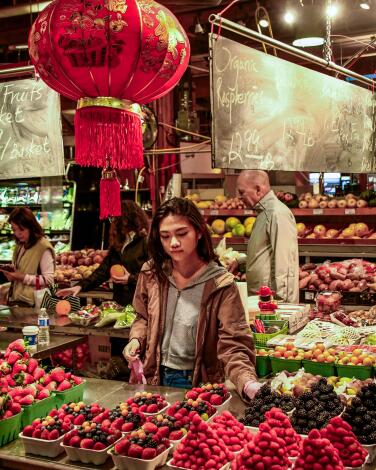
Taste and shop postindustrial Granville Island
Now you can’t miss it. Entirely industrial in the early 1970s, this waterfront beneath the Granville Street Bridge has been 99% transformed into a place where visitors and locals eat, drink, play and watch one another. It began in 1979 with a public market (open 9 a.m. to 7 p.m. daily), now joined by artists, artisans, performing arts, dozens of shops and the Granville Island Hotel. It’s also the hub of False Creek Ferry and Aquabus traffic.
“It’s a bit of an eye-opener — fresh produce and some of the best seafood in the world,” False Creek Ferry skipper Brad Parker told me as he sidled our vessel to the dock. (He could have mentioned the pickles, Nanaimo bars (a B.C. favorite) and the provocative Nooroongji Books too.)
I love everything about public markets except that moment when you’re looking at strawberries but beginning to smell fish.
Otherwise, fish are fine. In fact, get lunch at Go Fish, which operates in a tin shack 100 yards west of Granville Island on Island Park Walk. Order a grilled salmon tacone (sort of a taco, sort of a cone, with salsa, cream and slaw; about $6). It’s heartier than a taco, tastier than you can imagine.
Tip: Even the portion of Granville Island that’s still industrial — the Ocean Concrete factory — has gone artsy. Brazilian artists Gustavo and Otávio Pandolfo have painted immense, amusing murals on its 70-foot storage silos. You can see them from the creek.
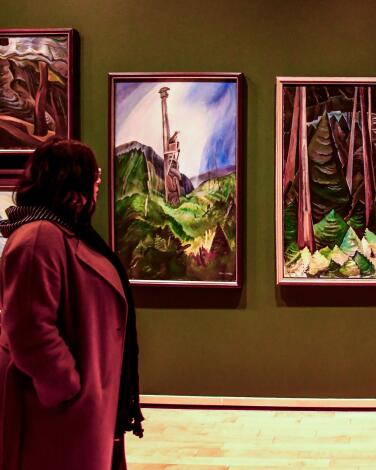
Meet a pioneering painter in the Vancouver Art Gallery
“Emily Carr: A Room of Her Own,” an exhibition of 25 Carr paintings owned by the museum, will be up through Jan. 5. Born in 1871, Carr studied in San Francisco and Europe but returned to spend most of her life on Vancouver island, painting landscapes and First Nations villages. She also did illustrations and cartoons, taught, bred sheepdogs, kept a pet monkey and wrote several volumes of memoirs. She died in 1945 at 73.
“There is something bigger than fact: the underlying spirit, all it stands for, the mood, the vastness, the wildness,” Carr wrote.
There’s much more to the museum than Carr. Look for the Group of Seven, a collection of Canadian landscape artists. And you’re bound to smile at “Horizons,” a presentation by artist Gary Neill Kennedy (through Aug. 25) in which dozens of the museum’s paintings are rehung so that their horizons line up.
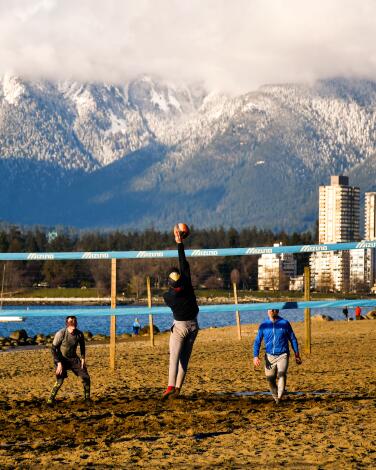
Play on Kitsilano, a beach where hippies once crashed
You might not guess that this was a hippie enclave in the late ’60s, it’s so tidy and glamorous now, but the Grateful Dead, Janis Jopin and Jefferson Airplane were all here in 1966, winning over early converts.
As author and artist Douglas Coupland writes in “City of Glass” (a 176-page ode to his hometown), “much of what defines Vancouver comes from the great hippie push: no freeways, Greenpeace, regional cuisine and fusion foods, utopian urban planning schemes, plus a heady sense of personal freedom that is slightly absent in other cities.”
I went to the beach, where there were three volleyball games happening on the sand, despite a temperature near 35 degrees. You’ll also encounter the longest swimming pool in Canada (a 450-foot salt water public pool by the beach.) When you get hungry, remember that I had the best dinner of my visit at Maena, a modern Thai restaurant on West 4th Avenue. The restaurant is about 10 years old, impeccable furnished with a couple of Warhol animal prints, a terrazzo bar (six seats), about a dozen tables and two or three booths in an elevated room to the rear. My grilled beef salad was amazing, about $25, with the beef enlivened by peppers.
Also nearby: the Museum of Vancouver and the Vancouver Maritime Museum, where False Creek Ferries pick up and drop off.
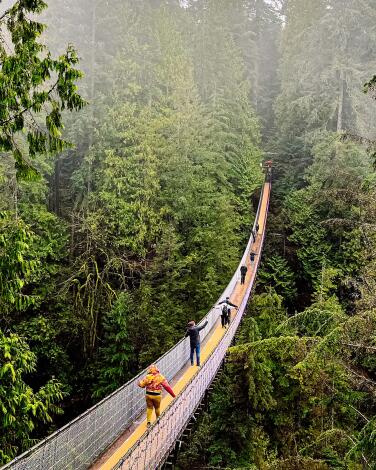
Tiptoe high above a misty forest on the Capilano Suspension Bridge
The park also has a Treetops area, a series of platforms high in the trees, connected by elevated walkways, but it’s closed for an upgrade in 2024.
But really, the bridge is worth the price of admission (about $45 and up for adults, $18 to $25 for minors). It’s 450 feet long, 230 feet above the Capilano River, about 5 feet wide.
“My first time on a suspension bridge. It moves a lot,” Raul Cruz of Chicago told me, standing shakily midspan.
“My God! This is dangerous,” said another man as a teenage girl snickered behind him. I’m guessing they were related.
More than 3,000 people per day come through on busy days, so it’s wise to arrive soon after opening (8:30 a.m. in summer). The park operates free shuttle buses that run several times a day, so you can catch a ride at Canada Place, the Hyatt Regency or the Blue Horizon Hotel.
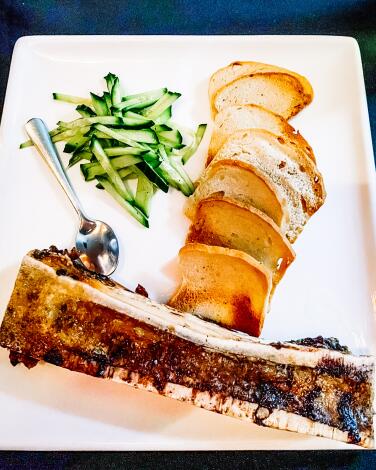
Savor the game (or veggies) at Vancouver's only Indigenous restaurant
If you’re a full-on carnivore, try the bison bone marrow. If not, you’ll find a great veggie risotto further down the menu. (You can get a 4-ounce hunk of salmon on top.)
There’s plenty to look at inside. One wall is red. The dining room is crowded full of Native art for sale.
For most of my evening there, the background music was First Nations chants and drumming. Then the hostess called the restaurant to attention so we could sing “Happy Birthday” to a guest — and then the Indigenous family at another table volunteered to sing it in their native language. Smiles all around. (There are hundreds of Native languages in the part of North America that’s now Canada, and the restaurant staff’s heritage includes more than a dozen First Nations.)
Main dishes are generally $15 to $30. For another $4.50 or so, you can finish up with fresh berries on ice cream.
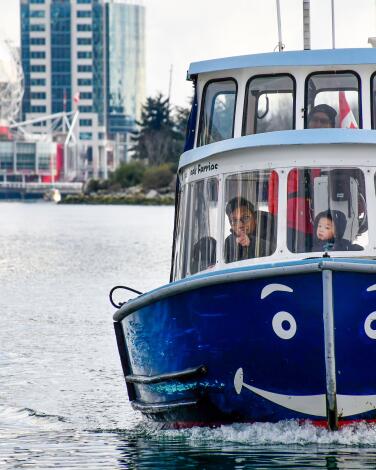
Cruise False Creek by ferry
These vessels carry adults, children and pets, up to 20 people at time. Of the two companies running ferry service, I liked False Creek Ferries (about 15 vessels, calling at nine stops), because those boats go west of the Burrard Street Bridge and because they look like little tugboats.
That said, the rival Aquabuses (about 13 of them, calling at eight stops) are decorated in rainbow colors and most are platform boats (barges) that accept bicycles and wheelchairs. They don’t go west of the Burrard Street Bridge but are in and out of Granville Island constantly.
With either company, you can buy one ride at a time, a round-trip or a day pass ($14-$15). Be sure to ride at least once after dark, when the city lights are reflected in the water.
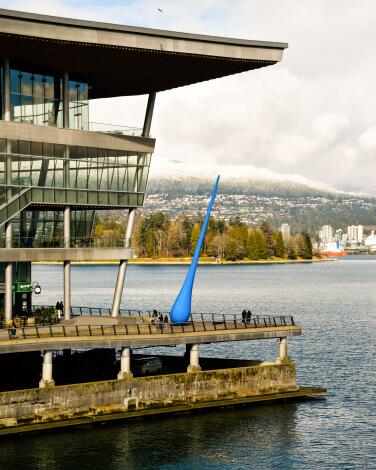
See the 65-foot-high raindrop by Canada Place
This is the gathering place and transportation hub overlooking Vancouver Harbor where you can watch sea planes and cruise ships come and go while mountains loom across the water. It’s where you can see “Flyover,” an immersive presentation that simulates flight over Canada and other destinations. Canada Place is also next door to Waterfront Station, where you can board the SkyTrain for a 25-minute ride to Vancouver’s international airport.
Also next door (on the western side) is Vancouver’s convention center, where you should check out two pieces of public art: “The Drop,” a 65-foot-high blue raindrop by artist Inges Idee; and “Digital Orca,” a pixelated, yet three-dimensional leaping whale by Vancouver-based artist and author Douglas Coupland.
Several major hotels are within a few blocks. Many visitors head from here on foot to the historic Gastown (where you’ll find an old steam clock and a gritty jumble of tourist shops, restaurants and hostels, revitalization pending); or to Chinatown (where you’ll find the Dr. Sun Yat-Sen Classical Chinese Garden).
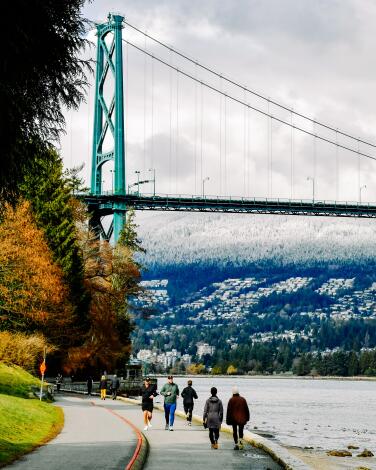
Pedal (or walk or skate) along the scenic Stanley Park Seawall
The park is surrounded on three sides by water — and by the Stanley Park Seawall, a path that draws walkers, runners and cyclists in all seasons. It’s a 6-mile route around the park, taking you past almost as many spectacular views as Tim Horton has doughnuts. (It’s part of the 17-mile Seaside Greenway from Canada Place to Spanish Banks Park.)
Start on Denman Street, near the entrance to Stanley Park, where several rental companies compete within two blocks, renting bikes for as little as $5.50 hourly. I chose an e-bike from Bikes and Blades (about $22 for two hours) and paid extra to keep the bike a bit longer.
That was worth it. I stopped for the Brockton Point lighthouse, the totem poles, the 364-foot-high Lions Gate bridge, the dramatic outcropping of Siwash Rock and in English Bay, where Yue Minjun’s “A-Maze-Ing” bronze sculptures of 14 laughing men charms children and adults alike.
Bonus tip: There’s often a hot dog vendor next to Morton Park. If you buy one, beware those gulls.
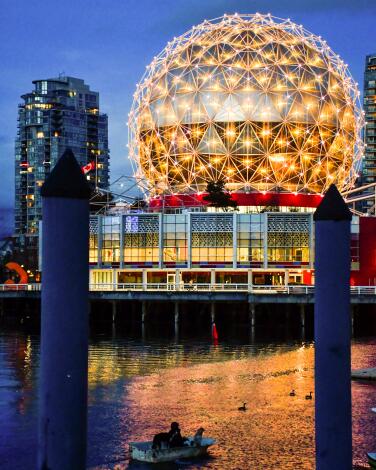
Find the big dome (and lots of beer) in Vancouver's Olympic Village
Flash forward and the dome now houses Science World, an interactive museum aimed at families and focused on science and nature. The village includes about 1,100 condos clustered around a village square dominated by two sparrows, each about the size of King Kong (public art).
Still, it’s the dome you notice from a distance, especially if you’re plying the waters of False Creek, especially after dark. I took a ferry to the village one night for a good look, then walked over to Craft Beer Market, an enormous beer hall (part of a Canadian chain), formerly a salt factory. Also nearby: Tap & Barrel restaurant, Mahony’s Tavern and Brewhall. You won’t go thirsty.
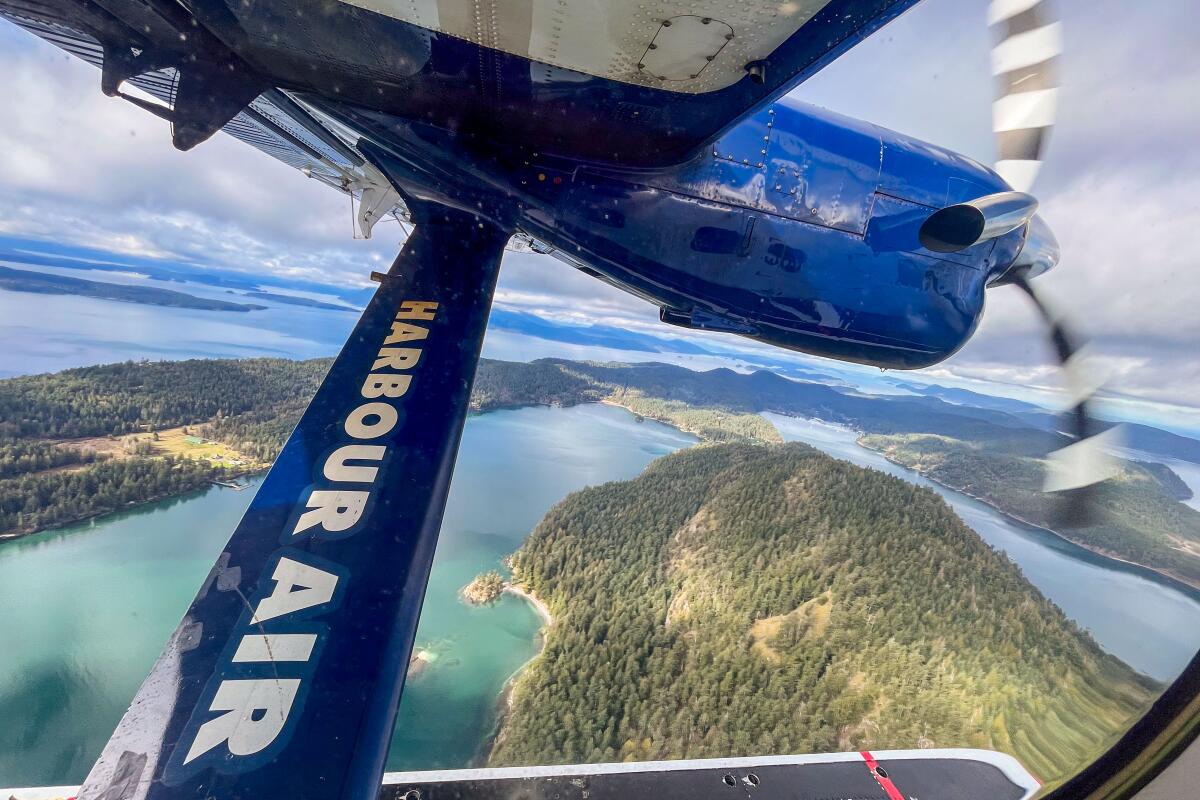
Soar by seaplane between Vancouver and Vancouver Island
Seaplanes aren’t for everyone, to be sure. But for those who don’t mind close quarters and landing on pontoons, the benefits are many.
The seaplane journey begins with a takeoff in Vancouver Harbor, with a city skyline on one side and dramatic mountains on the other. You zoom over open sea, cargo ships, a handful of heavily forested islands, driftwood-filled beaches and enviable coastal homes. Then you splash down (gently) in Victoria Harbor, where the tiny, pleasant terminal is at the end of a dock, within walking distance of the Inner Harbor area’s hotels.
Harbour Air, the dominant flier of seaplanes in the region, makes the trip 15 or more times a day and hasn’t had a fatality in this century). My flight was in a 20-seat de Havilland Twin Otter aircraft, six seats occupied.
Flying on low-demand days in the off-season (and meeting a luggage weight limit of 8 pounds), I was happy to pay about $80 each way. A 20-minute sightseeing flight over Vancouver Harbor would have cost more.
Harbour Air offers various sightseeing flights along with regular service between Vancouver and Whistler, Seattle and several other destinations. Also, for the record: Some aviation insiders insist that seaplanes land on their bellies, while float planes land on pontoons. Harbour Air’s planes use pontoons, but Harbour Air calls them seaplanes.
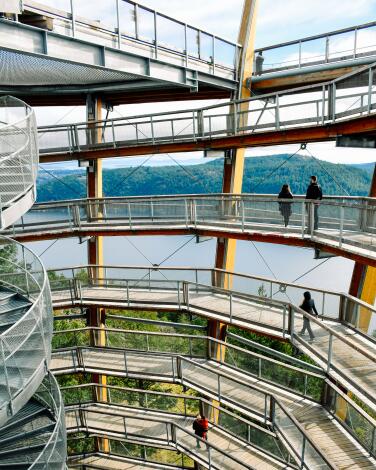
Climb and slide the open-air Malahat Skywalk
The tower is about half an hour northwest of Victoria. Even after parking, you don’t see it at first. After paying ($27 per adult), you walk about 500 yards of elevated boardwalk through a forest of arbutus (Pacific Madrone) trees. Then the cylindrical tower rises before you, made of Douglas fir and steel. You see a ramp. And no elevator.
The ramp spirals gradually upward (an incline of 5% to 8%). You climb as if circling the cylindrical, wall-free Guggenheim Museum in Manhattan — but you’re admiring nature beyond instead of art within. As you rise, you feel the breeze and see more on the horizon, more of the waters at the foot of the slope.
“Just gorgeous,” said Maliana Kaui, visiting from Tacoma, as she stood on top.
“We get quite a lot of people in wheelchairs,” maintenance worker Travis Nickel told me. “Even on the slide. It was all designed to be accessible.”
“The slide” is a 165-foot-long twisting stainless-steel tube, beginning at the top of the tower. As you zoom down, the tube drops 65 feet. It takes about 10 seconds — very smooth, very fast, very shiny, like being sucked into a mirror.
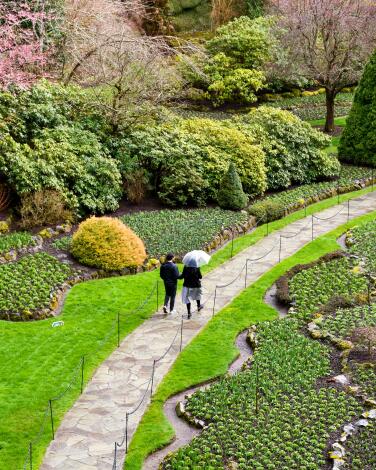
Roam among riotous flowers at Butchart Gardens
Some 900 varieties of plants grow here. Yet part of the gardens were an industrial site. When Robert and Jennie Butchart moved here in 1904, it was to run a quarry and cement plant, drawing on local limestone deposits. By 1912, those deposits had been exhausted, family finances were flush and Jennie Butchart had hit on the idea of carting in topsoil to fill the quarry areas. So began a sunken garden. By the 1920s, the Butcharts (and workers) had created Japanese, Italian and rose gardens.
The gardens are about 14 miles outside Victoria. Even in late winter, when bulbs haven’t popped up and many flower displays are indoors, it’s spectacular. Ponds and fountains. A carousel for kids. Twenty-six greenhouses and 50 gardeners. It will remind some people of Huntington Gardens in San Marino, but not for long. There’s no library or art collection at the Butchart Gardens — but pets are allowed.
There is a gift shop, and a dining room, casual restaurant, coffee shop and ice cream stand. Adult admission ranges from about $16 to $30, depending on the season. And if you want to take high tea on Vancouver Island, as many travelers do, why not try it in the Butchart Gardens dining room for $36, rather than spending twice as much at the Fairmont Empress Hotel in Victoria?
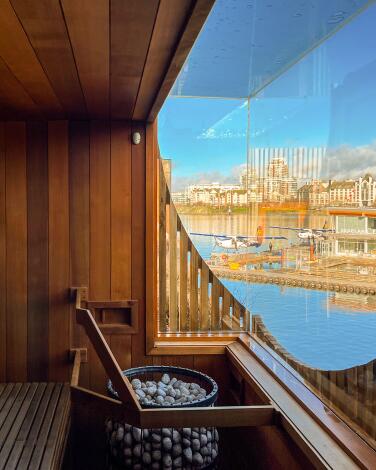
Board a Victoria Harbor warship that's been taken over by sauna people
A: It’s called HAVN (and pronounced hahven). It was built to serve in World War II as a U.S. Navy barge. Now it’s a sort of floating day spa, with three sauna rooms, each with a different temperature, scent and view. There are two hot tubs, two cold pools, exfoliation shower, relaxation cabin, boutique and a decktop lounge with views of the harbor. And on the bow, you’ll notice the words Built 1943, refitted 2023 .
The enterprise, which is locally owned, opened in June 2023. The wooden slats are salvaged cedar driftwood from British Columbia’s Haida Gwaii islands.
It never leaves the dock, which is a short stroll from the grandest old buildings on Victoria’s waterfront. Guests get three hours’ run of the place for about $65. Instead of labeling it a spa, management calls it a “floating park environment.”
It’s open daily, 9 a.m. to 9:45 p.m., with herbal tea and snacks available, including cheese and charcuterie boards.
“We’re a cellphone-free facility. Part of our whole M.O. is to be in the present moment,” said general manager Jayme Beaudry.
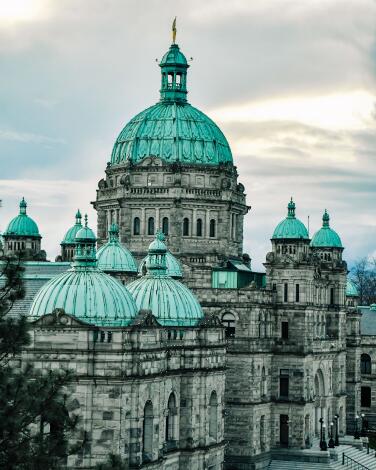
Chase history around Victoria's Inner Harbor on Vancouver Island
Just look at the Parliament Buildings, home to British Columbia’s Legislative Assembly, designed by Francis M. Rattenbury and completed in the 1890s. The main dome is a knockout when the sun hits its green skin of oxidized copper. Then at dusk it gets better: Thousands of lights illuminate the buildings’ contours. On weekdays, you can take free guided tours and the Parliamentary Dining Room is open for breakfast and lunch.
A block away stands the Fairmont Empress Hotel, designed by the same architect, completed in 1908, revered for its traditional tea service (11 a.m. to 2 p.m. daily; about $70 each). In that tea room, British Columbia feels especially British.
Also nearby is the Royal B.C. Museum, a humdrum 1960s building that’s open but in awkward transition. Its First Peoples displays have been closed since 2021 “as we work to reimagine them with communities.”
For more hints of Victoria 120 years ago, walk down Government Street, Bastion Square and Wharf Street. I loved dinner in the evocative, windowless dining room of Little Jumbo (mushroom risotto, about $24) and wished for more time in the 1909 bank building that houses Munro’s Books.
If you’re spending the night, the 30-room Abigail’s Hotel is a pleasant adults-only lodging half a mile from the harbor. Most of the bedrooms are upstairs in historic buildings without elevators. My room cost about $160 at off-season rates, with a three-course breakfast included.
Sign up for This Evening's Big Stories
Catch up on the day with the 7 biggest L.A. Times stories in your inbox every weekday evening.
You may occasionally receive promotional content from the Los Angeles Times.



